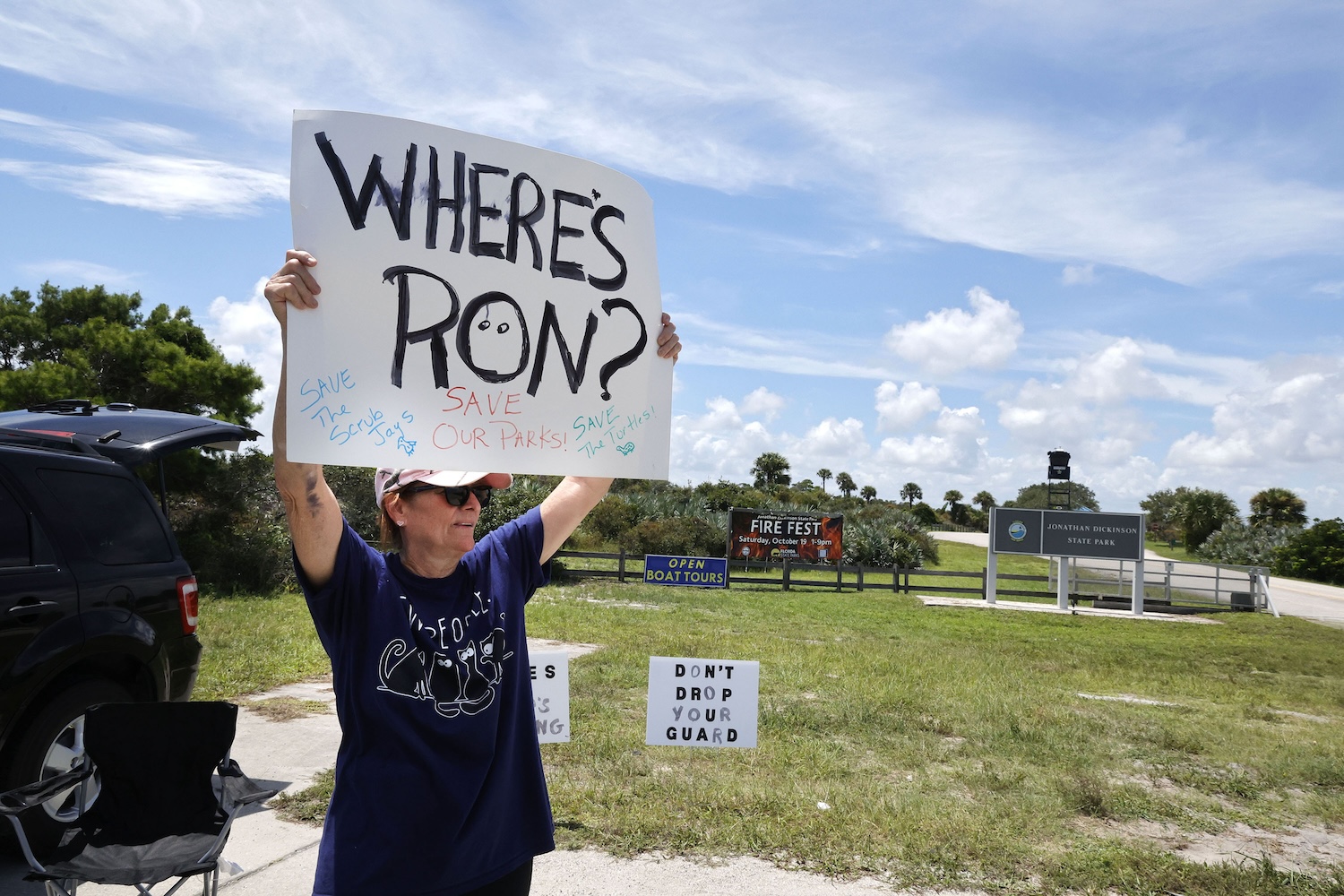Tucker Carlson has used his platform to, among other things, undermine climate science and lie about renewable energy. Yet last week, he put out an impassioned plea to save the Maine woods, claiming that “real environmentalists” should oppose a power line connecting Quebec hydropower to the U.S. Bizarrely, he and the Sierra Club are on the same page.
The segment and the alignment with traditional environmental groups paint a picture of how complex renewable energy projects can be for local communities—and what the upcoming culture war over renewables might look like.
The project that attracted Carlson’s wrath is a proposed 145-mile (233-kilometer) transmission line owned by local power company Central Maine Power that is intended to connect hydropower produced in Canada to the grid in Massachusetts, all in the service of helping the state meet its ambitious climate goals. Construction began in February despite numerous legal challenges from green groups and a bitter public relations war that has dragged on for years in the state.
The tone of Carlson’s segment is over-the-top dramatic, often in an unintentionally funny way. Most of it is set over a soundtrack of racing violins or pounding drums. At one point, the camera zooms in on an animal skull below footage of powerlines, as if to suggest instant death from coming into contact with a transmission line—which, in case you need reminding, are pretty normal pieces of the energy grid. The segment also seems tailor-made to appeal to people in the region. One of the interviewees is filmed in what looks like a woodland lodge bar that prominently displays a bottle of Allen’s Coffee Brandy and a can of Moxie—two drinks produced in Maine and beloved by Mainers—on the bar next to him in the shot. Another says that “there is no doubt Tom Brady is the GOAT” in a seemingly completely unrelated aside during his interview.
“The whole state of Maine will become an ugly place” with the project, one of the interviewees tells Carlson.
While this dramatic production may seem funny, it also paints a picture of how aggressive opposition to new renewable energy projects can be even though many are relatively innocuous pieces of infrastructure in the grand scheme of things—and are necessary to avert catastrophic climate change. And yet—I can’t believe I’m saying this—tone aside, Carlson does a not-terrible job of laying out some of the facts of the case. He describes the environmental issues with the proposed corridor, including how it endangers what’s among the most robust natural habitat for the trout in the U.S., as well as the failure to consult with local communities. He even technically gives the emissions calculations of the project a (very small) sliver of airtime: The segment addresses the facts that cutting down trees eliminates their ability to sequester carbon and that the reservoirs that form behind hydropower dams emit methane, a potent greenhouse gas.
These issues are key reasons why environmental groups have opposed the transmission project as well, including that the project wouldn’t reduce overall emissions but rather just ship clean power that would’ve been used elsewhere to Massachusetts.
“This is a shell game,” said Sue Ely, a staff attorney at Natural Resources Council of Maine. “It’s not renewable energy, it doesn’t help Maine’s renewable energy industry, and it’s very damaging to Maine’s environment.”
NRCM filed a lawsuit last fall with the Sierra Club challenging the federal government’s environmental impact review of the project. Indeed, what’s riled up most local opposition—and what Carlson’s report focused on—is the project’s proposal to clear 53 miles (85 kilometers) of new transmission corridor in Maine’s North Woods, a 3.5 million acre chunk of wildland that borders Canada. The North Woods is the biggest undeveloped forest in the eastern U.S., and makes up more the half the state itself. It’s also a big economic driver for a state that’s been struggling in the post-industrial era, with a thriving timber industry and thousands of visitors each year. Tourism is an enormous sector of Maine’s economy; rafting, snowmobiling, and camping are all prominent sources of revenue in the North Woods that would be negatively impacted by visible power lines.
“There are tons of transmission corridors in the state, but CMP snaked this line right in between the protected areas,” said Ely. “They slalomed through it.”
A spokesperson for Clean Energy Matters, the CMP-owned lobbying organization for the project, said in an email that these claims “were presented to and ultimately rejected by the Maine Public Utilities Commission and Massachusetts regulators.” (The group also said in a statement to the Bangor Daily News that CMP wasn’t allowed to participate in the Carlson segment, and that producers used stock footage and “false descriptions” of the project.)
Even before Carlson—who owns a home in Maine and has even broadcast his show from the state—showed up with his cameras, there was plenty of mudslinging around the corridor project to be had on both sides. Clean Energy Matters has spent nearly $20 million in advertising on a pro-corridor campaign. Both groups like NRCM and the Sierra Club as well as Carlson in his segment repeatedly refer to CMP as “foreign-owned” (CMP is owned by Connecticut-based Avangrid, which, in turn, is owned by the Spanish energy giant Iberdrola)—a term that’s been used in other energy fights to stoke xenophobic fears and images of foreigner stealing American jobs.
The spokesperson for Clean Energy Matters pointed out in an email to Earther that some opposition efforts to the corridor project “are funded by three corporations with oil, natural gas, and nuclear generating stations in Maine, New Hampshire, and Massachusetts.” Those companies are Calpine, Vistra, and NextEra, which have poured their own millions into advertising campaigns against the project. Clean Energy Matters has also attacked NRCM for what it says are ties to natural gas groups after NRCM got a donation from an anti-corridor group with murky funders.
“It’s so vicious,” Ely said of the fight. “It really hardens people.”
And, like many local fights, the actual issues at hand—lowering greenhouse gas emissions and figuring out how to best fit renewables into the local landscape—seem to be getting lost in the brawl. Caratunk, a 68-person town along the proposed transmission line’s route, had been working with NextEra on installing a proposed 150-megawatt solar farm. The chair of Caratunk’s selectboard said in a 2018 letter to the Maine Public Utilities Commission that the CMP corridor project would prevent the development of this project and potentially other local renewables projects in the area. The selectboard chair appeared in the Carlson segment as a voice of local opposition, with no mention of the alternative solar project. While there’s a chance the selectboard chair didn’t bring up the project with producers, it’s not out of the question to think that Carlson’s team didn’t want to spotlight how opponents of the “green energy scam,” as they called the CMP project, might be in favor of other renewable energy ventures in Maine.
The brook trout in the North Woods—or the lobster in the Gulf of Maine or any of the state’s other ecosystems for that matter—can’t hang on much longer if our planet keeps baking at the rate it’s going. Weighed out on a cosmic scale, if cutting 53 miles through a pristine section of woods could help an enormous energy-using state keep its emissions down, it might be worth it, despite the big local tradeoffs. That seems to be the attitude of some conservation and environment groups in the state who have begrudgingly signaled their support—or, at least, the end to their opposition—for the project in recent weeks.
I asked Ely about this challenge. If the CMP project was bringing a completely uncontested source of renewable power into New England—or, perhaps, if a transmission line through the North Woods could be connected to a renewable project that serves Maine and creates renewable energy jobs in the state—would the green groups be so opposed? She sighed.
“I have felt really fortunate in this fight that I have not had to answer that question—it’s a really good question,” she said. “In Maine, if we really want to do what our governor says—reach net zero by 2045, reduce our emissions by 80% by 2050—it’s going to require this massive buildout of renewable energy resources and a massive electrification of everything we can possibly electrify. We need to grow our grid somewhere in the ballpark of three times, and that is going to require building these massive transmission structures. And this anti-transmission line fervor is really going to hinder our ability to reach our clean energy goals.”
It’s that fervor Carlson seems intent on stoking, though based on his past body of work, it’s for reasons likely less in line with those of local environmental group.
“This corridor is more than an energy project—it’s an attack against rural America and the people who live there,” Carlson said in his segment. That is, of course, untrue, but he’s setting the stage for his audience to view all renewable energy projects with skepticism and as an attack on the environment. If conversations around renewable projects can’t stay honest—and if big companies that plan to profit off the energy transition don’t start thinking about the local impacts of what they’re doing—there will be plenty of fodder for the culture war to come.














